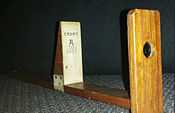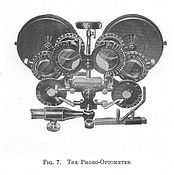Optometer (ophthalmic instrument)
A device, used for measuring spherical and/or cylindrical prescription for eyeglasses and contact lenses, from the middle of the 18th century until around 1922, when modern instruments were developed.[1][2][3] The term, coined in 1738 by W. Porterfield to describe his Scheiner slit optometer,[4] and used for 200 years to describe many different inventions to measure refractive error of the eye, has completely fallen out of usage today as the task of measuring eyes for spectacles is done with modern instruments, such as the phoropter.
Examples of Optometers
-

18th century style slide optometer
-

Johnston Optometer of 1882
-

1882 Patent for Johnston Optometer[1]
-

Bertelings Compound Optometer of 1885, back view.[2]
-

Bertelings Compound Optometer of 1885, front view.[3]
-

DeZeng's Phorometer Trial Frame of 1909.[4]
-

DeZeng's Phoro-Optometer of 1917.[5]
-

DeZeng's Phoro-Optometer of 1917 with wall mount.[6]
- ^ U.S. Patent Office
- ^ "Instructions for L. A. Berteling's Compound Optometer," 1885, L. A. Berteling, George Spaulding & Co. San Francisco, p. 17
- ^ "Instructions for L. A. Berteling's Compound Optometer," 1885, L. A. Berteling, George Spaulding & Co. San Francisco, p. 16
- ^ "The Modern Phorometer," 1917, Henry DeZeng, self-published, Camden New Jersey, p.26
- ^ "The Modern Phorometer," 1917, Henry DeZeng, self-published, Camden New Jersey, p 46
- ^ "The Modern Phorometer," 1917, Henry DeZeng, self-published, Camden New Jersey, frontispiece
A phoropter is one of several generic names for modern instruments containing an optometer (battery of lenses for determination of optical error), combined with prisms and other attachments for measuring binocularity. The term refractor is another such term, and "vision tester" or other descriptive terms are used because phoroptor, spelled with "-or", is actually a trademark of one company.[5]

The modern phoropter or refractor
A century ago, doctors tested for optical error using single hand-held lenses, held one at a time in front of the patient's eye, or in a trial frame. A wooden case with dozens or hundreds of lenses was held on the doctor's lap, or in a case near the patient's chair, as he or she examined the patient. Eyes were also measured using an optometer, a name for various devices invented starting in the 18th century, originally for measuring a patient for reading glasses, but later for distance glasses as well. Various patented or unpatented optometers were sold throughout the 19th and early 20th centuries, some containing rotating batteries of lenses in various arrangements, usually with the name of an inventor in front of it. Binocularity was tested using trial frames which sat on the patient's face or on a support bar, with extra testing devices added to the front of the frames, such as Maddox rods, rotating prisms, and phorometers. The refraction part of the exam was done with trial lenses that fit into the back of the frame. Optometer was the generic name for devices, crude and simple, with rotating batteries of sphere and cylinder lenses placed in front of each eye, one at a time, so there was no testing for binocularity. When the optometer and phorometer trial frame were combined into single instruments, the modern refractor/phoropter was born, which happened in 1917 when two companies in the New York City area began to market competing versions.[6]
Rodenstock of Germany has its own similar vision tester, with a completely different design and history to the American models, and France, the UK and maybe other European countries have also developed similar devices. The history of European refractors is mostly separate from the American. Other parts of the world, however, especially Asia, have mostly copied and retooled the American and European products.
See also
| Wikimedia Commons has media related to Phoropter. |
- Phoropter
- Ophthalmic lens
- Ophthalmologist
- Optometrist
- Orthoptist
References
- ↑ "The Modern Phorometer," 1917, Henry DeZeng, self-published, Camden New Jersey
- ↑ "Instructions for L. A. Berteling's Compound Optometer," 1885, L. A. Berteling, George Spaulding & Co. San Francisco
- ↑ "Ein Neues Optometer," 1863, Karl Burow, Berlin
- ↑ "Thomas Young's Contribution to Visual Optics", Journal of Vision, Oct 14, 2010, David A. Atchison and W. Neil Charman.
- ↑ "Visual Optics and Refraction" by David D. Michaels, Mosby 1980, p. 232
- ↑ phoropter